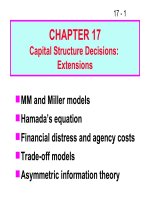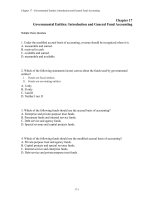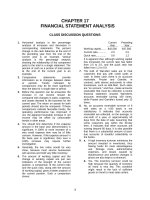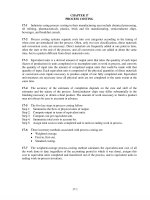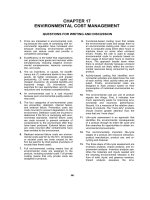Accounting26th ch 17
Bạn đang xem bản rút gọn của tài liệu. Xem và tải ngay bản đầy đủ của tài liệu tại đây (917.7 KB, 18 trang )
CHAPTER
17
Financial Statement
Analysis
Warren
Reeve
Duchac
©2016
human/iStock/360/Getty Images
Accounting
26e
Horizontal Analysis
•
The analysis of increases and decreases in the amount
and percentage of comparative financial statement
items is called horizontal analysis.
o
•
Each item on the most recent statement is compared with the
same item on one or more earlier statements in terms of the
amount of increase or decrease and the percent of increase
or decrease.
When comparing statements, the earlier statement is
normally used as the base year for computing
increases and decreases.
©2016
Vertical Analysis
•
•
The percentage analysis of the relationship of each
component in a financial statement to a total within
the statement is called vertical analysis.
In a vertical analysis of the balance sheet, the
percentages are computed as follows:
o
o
•
Each asset item is stated as a percent of the total assets.
Each liability and stockholders’ equity item is stated as a
percent of the total liabilities and stockholders’ equity.
In a vertical analysis of the income statement, each
item is stated as a percent of sales.
©2016
Common-Sized Statements
•
•
In a common-sized statement, all items are
expressed as percentages, with no dollar amounts
shown.
Common-sized statements are useful for comparing
one company with another or comparing a company
with industry averages.
©2016
Liquidity and Solvency Analysis
(slide 1 of 2)
•
All users of financial statements are interested in the
ability of a company to do the following:
o
o
•
•
Maintain liquidity and solvency
Earn income, called profitability
The ability of a company to convert assets into cash is
called liquidity, while the ability of a company to
pay its debts is called solvency.
Liquidity, solvency, and profitability are interrelated.
©2016
Liquidity and Solvency Analysis
(slide 2 of 2)
• Liquidity and solvency are normally assessed using the following:
o
Current position analysis
Working capital
Current ratio
Quick ratio
o
Accounts Receivable analysis
Accounts receivable turnover
Number of days’ sales in receivables
o
Inventory analysis
Inventory turnover
Number of days’ sales in inventory
o
o
o
The ratio of fixed assets to long-term liabilities
The ratio of liabilities to stockholders’ equity
The number of times interest charges are earned
©2016
Current Position Analysis
•
•
A company’s ability to pay its current liabilities is
called current position analysis.
Current position analysis is a solvency measure of
special interest to short-term creditors and includes the
computation and analysis of the following:
o
o
o
Working Capital
Current ratio
Quick ratio
©2016
Profitability Analysis
•
Common profitability analyses include the following:
o
o
o
o
o
o
o
o
Ratio of sales to assets
Rate earned on total assets
Rate earned on stockholders’ equity
Rate earned on common stockholders’ equity
Earnings per share on common stock
Price-earnings ratio
Dividends per share
Dividend yield
©2016
Summary of Analytical Measures
(slide 1 of 2)
©2016
Summary of Analytical Measures
(slide 2 of 2)
©2016
Corporate Annual Reports
•
In addition to the financial statements and the
accompanying notes, corporate annual reports
normally include the following sections:
o
o
o
Management discussion and analysis
Report on internal control
Report on fairness of the financial statements
©2016
Management Discussion and Analysis
• Management’s Discussion and Analysis (MD&A) is required in annual
•
•
reports filed with the Securities and Exchange Commission.
It includes management’s analysis of current operations and its plans for the
future.
Typical items included in the MD&A are:
o
o
o
o
o
Management’s analysis and explanations of any significant changes between
the current and prior years’ financial statements.
Important accounting principles or policies that could affect interpretation of the
financial statements, including the effect of changes in accounting principles or
the adoption of new accounting principles.
Management’s assessment of the company’s liquidity and the availability of
capital to the company.
Significant risk exposures that might affect the company.
Any “off-balance-sheet” arrangements such as leases not included directly in the
financial statements.
©2016
Report on Internal Control
•
The Sarbanes-Oxley Act of 2002 requires a report
by management.
o
o
•
The report states management’s responsibility for
establishing and maintaining internal control.
In addition, management’s assessment of the effectiveness
of internal controls over financial reporting is included in the
report.
Sarbanes-Oxley also requires a public accounting
firm to verify management’s conclusions on internal
control.
o
Thus, two reports on internal control, one by management
and one by a public accounting firm, are included in the
annual report.
©2016
Report on Fairness of the Financial Statements
•
•
All publicly held corporations are required to have an
independent audit (examination) of their financial statements.
The Certified Public Accounting (CPA) firm that conducts the
audit renders an opinion, called the Report of Independent
Registered Public Accounting Firm, on the fairness of the
statements.
©2016
Appendix: Unusual Items
on the Income Statement
•
Generally accepted accounting principles require that
unusual items be reported separately on the income
statement.
o
•
This is because such items do not occur frequently and are
typically unrelated to current operations.
Unusual items on the income statement are classified
as one of the following:
o
o
Affecting the current period income statement
Affecting a prior period income statement
©2016
Appendix: Unusual Items Affecting the Current
Period’s Income Statement—Discontinued Operations
•
A company may discontinue a component of its
operations by selling or abandoning the component’s
operations.
o
o
If the discontinued component is (1) the result of a strategic
shift and (2) has a major effect on the entity’s operations
and financial results, any gain or loss on discontinued
operations is reported on the income statement as a Gain
(or loss) from discontinued operations.
A note to the financial statements should describe the
operations sold, including the date operations were
discontinued, and details about the assets, liabilities, income,
and expenses of the discontinued component.
©2016
Appendix: Unusual Items Affecting the Current
Period’s Income Statement
•
An extraordinary item is defined as an event or transaction
with both of the following characteristics:
o
o
o
•
Unusual in nature
Infrequent in occurrence
Any gain or loss from extraordinary items is reported on the income
statement as Gain (or loss) from extraordinary item.
Earnings per common share should be prepared separately in
the notes to the financial statements for discontinued operations
and extraordinary items.
©2016
Appendix: Unusual Items Affecting the
Prior Period’s Income Statement
•
An unusual item may occur that affects a prior
period’s income statement.
o
Two such items are as follows:
Errors in applying generally accepted accounting principles
Changes from one generally accepted accounting principle to
another
©2016
